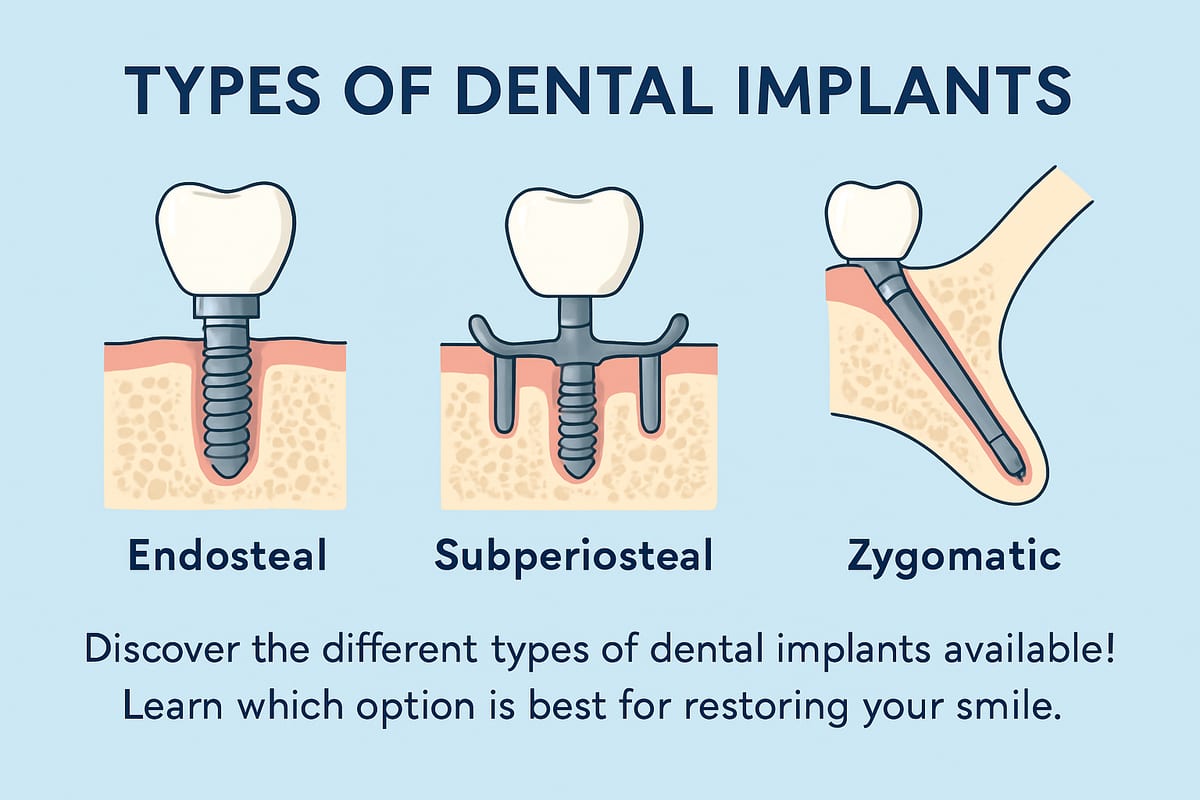This quick, 500-word guide explains the types dental implants available, how they differ, and how to pick the right one for your needs. If you are missing one tooth, several teeth, or a whole arch, this guide will help you understand common options and the practical steps to move forward.
Read on to learn what an implant includes, the main implant types, and the questions to bring to your dental consult so you can make a confident choice.
What are dental implants?
Dental implants are a permanent way to replace missing teeth. A typical implant has three parts: the implant post (a titanium or zirconia screw placed in the jaw), an abutment that connects the post to the visible tooth, and a crown or prosthesis that looks and works like a natural tooth. Implants restore chewing power, help preserve jawbone by stimulating bone, and feel more stable than dentures.
Common types dental implants
Single-tooth (endosteal) implants
Single-tooth implants replace one missing tooth. The dentist places an implant post into the jaw, lets it fuse with bone, then adds an abutment and a crown. Pros: natural look, strong bite, long-lasting. Cons: requires enough bone and a longer healing time than a simple bridge.
Implant-supported bridge & partials
When you’re missing several teeth in a row, an implant-supported bridge uses two or more implants to hold multiple replacement teeth. This needs fewer implants than replacing each tooth. It’s a good option if you want a stable, fixed solution and want to avoid removing neighboring healthy teeth for a traditional bridge.
Full-arch solutions (All-on-4 / All-on-6)
Full-arch systems like All-on-4 or All-on-6 replace an entire upper or lower set of teeth with a single prosthesis supported by four or six implants. These solutions often allow faster restoration—sometimes with temporary teeth on the same day—and provide strong function and improved appearance. Typical timeline: consult and imaging, implant surgery, a healing period, then final prosthesis in a few months.
Mini implants and zirconia vs titanium options
Mini implants are smaller-diameter posts used mainly to stabilize removable dentures or in narrow jaw areas. They usually have simpler, quicker placement but can be less durable than full-size implants. Implant materials matter too: titanium is the most common for strength and proven success; zirconia is metal-free and may be chosen for aesthetic or allergy concerns. Each material has trade-offs in strength and appearance.
How to choose which type dental implants is right for you
Key factors to consider:
- Number and location of missing teeth
- Jawbone volume and quality (may need bone grafts)
- Overall health and habits (smoking, diabetes affect healing)
- Budget and whether you want a fixed or removable solution
- Timeline for treatment and recovery
Bone grafts or sinus lifts are common when bone volume is low. A dentist or implant surgeon will evaluate your X-rays, health history, and goals to recommend the best option for you.
Next steps — questions to ask and booking a consult
Bring these questions to your appointment:
- Which types dental implants do you recommend for my case and why?
- What is the total cost, and are there payment or financing options?
- What is the expected timeline from surgery to final teeth?
- How many similar cases have you treated and can I see before/after photos?
- What warranties or follow-up care do you offer?
Schedule a consult or get a second opinion to review imaging and a personalized treatment plan. A short exam and X-rays will clarify which types dental implants are the best fit for your smile and health.


